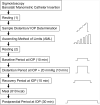Contributions of pain sensitivity and colonic motility to IBS symptom severity and predominant bowel habits
- PMID: 18684175
- PMCID: PMC3855425
- DOI: 10.1111/j.1572-0241.2008.02066.x
Contributions of pain sensitivity and colonic motility to IBS symptom severity and predominant bowel habits
Abstract
Objectives: Irritable bowel syndrome (IBS) patients show pain hypersensitivity and hypercontractility in response to colonic or rectal distention. Aims were to determine whether predominant bowel habits and IBS symptom severity are related to pain sensitivity, colon motility, or smooth muscle tone.
Methods: One hundred twenty-nine patients classified as IBS with diarrhea (IBS-D, N = 44), IBS with constipation (IBS-C, N = 29), mixed IBS (IBS-M, N = 45), and unspecified IBS (IBS-U, N = 11) based on stool consistency, and 30 healthy controls (HC) were studied. A manometric catheter containing a 600-mL capacity plastic bag was positioned in the descending colon. Pain threshold was assessed using a barostat. Motility was assessed for 10 min with the bag minimally inflated (individual operating pressure [IOP]), 10 min at 20 mmHg above the IOP, and for 15-min recovery following bag inflation. Motility was also recorded for 30 min following an 810-kcal meal.
Results: Compared with HC, IBS patients had lower pain thresholds (medians 30 vs 40 mmHg, P < 0.01), but IBS subtypes were not different. IBS symptom severity was correlated with pain thresholds (rho =-0.36, P < 0.001). During distention, the motility index (MI) was significantly higher in IBS compared with HC (909 +/- 73 vs 563 +/- 78, P < 0.01). Average barostat bag volume at baseline was higher (muscle tone lower) in HC compared with IBS-D and IBS-M but not compared with IBS-C. The baseline MI and bag volume differed between IBS-D and IBS-C and correlated with symptoms of abdominal distention and dissatisfaction with bowel movements. Pain thresholds and MI during distention were uncorrelated.
Conclusions: Pain sensitivity and colon motility are independent factors contributing to IBS symptoms. Treatment may need to address both, and to be specific to predominant bowel habit.
Conflict of interest statement
Conflicts of Interest and Author Roles: William E. Whitehead, Ph.D., is the guarantor of this paper, and he participated in study design, data collection, data analysis, and manuscript preparation. Motoyori Kanazawa, M.D., Ph.D., participated in study design, data analysis, and preparation of the manuscript. Olafur S. Palsson, Psy.D., participated in study design and data analysis. Syed IM Thiwan, M.D., participated in data collection. Marsha J. Turner, M.A., participated in data collection. Miranda AL van Tilburg, Ph.D., participated in data collection and data analysis. Lisa M. Gangarosa, M.D., participated in data collection. Denesh K. Chitkara, M.D., participated in data collection. Shin Fukudo, M.D., Ph.D., participated in data analysis and manuscript preparation. Douglas A. Drossman, M.D., participated in data collection. All financial support is declared in the acknowledgment, and none of the authors have competing interests.
Figures



References
-
- Whitehead WE, Holtkotter B, Enck P, Hoelzl R, Holmes KD, Anthony J, Shabsin HS, Schuster MM. Tolerance for rectosigmoid distention in irritable bowel syndrome. Gastroenterol. 1990;98:1187–1192. - PubMed
-
- Dorn SD, Palsson OS, Thiwan SIM, Kanazawa M, Clark WC, van Tilburg MAL, Drossman DA, Scarlett Y, Levy RL, Ringel Y, Crowell MD, Olden KW, Whitehead WE. Colonic pain sensitivity in Irritable Bowel Syndrome is the result of an increased tendency to report pain rather than increased neurosensory sensitivity. GUT. 2007;56:1202–1209. - PMC - PubMed
-
- Mertz H, Naliboff B, Munakata J, Niazi N, Mayer EA. Altered rectal perception is a biological marker of patients with irritable bowel syndrome. Gastroenterol. 1995;109:40–52. - PubMed
-
- Bouin M, Plourde V, Boivin M, Riberdy M, Lupien F, Laganiere M, Verrier P, Poitras P. Rectal distention testing in patients with irritable bowel syndrome: sensitivity, specificity, and predictive values of pain sensory thresholds. Gastroenterol. 2002;122:1771–1777. - PubMed
Publication types
MeSH terms
Grants and funding
LinkOut - more resources
Full Text Sources
Medical

